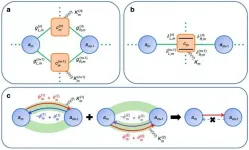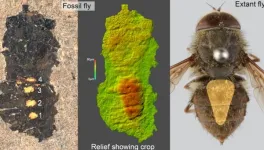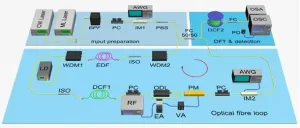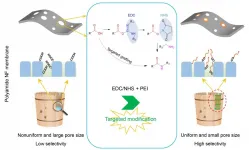AI holographic nanostructures on CMOS chips for energy-efficient security schemes
2021-03-11
(Press-News.org) Today, machine learning based methods are of our everyday life, with millions of users every day unlocking their phones through facial recognition or passing through AI-enabled automated security checks at airports and train stations. Traditionally, the processing of information native to the optical domain is being executed in the electronic domain, requiring energy-hungry specialized electronic hardware and conversion between the two realms. Optical machine learning is emerging as an important field, where the processing of optical information is done directly within the optical domain, power-efficient and at the speed of light.
Machine learning tasks, such as pattern recognition or image classification, rely heavily on the multiplication of large matrices, a resource-hungry computational task. Through machine-learning based design of optical elements with sub-wavelength feature sizes it is possible to perform these matrix operations directly in the optical domain, power-efficient through passive optical components. However, these passive optical elements are currently restricted in neuron size and density, while relying on bulky free-space optical systems, making them unsuitable for optical machine learning tasks in the visible wavelength regime and integration into compact designs.
In a new paper published in Light Science & Application, a team of scientists, led by Professor Min Gu from the Centre for Artificial Intelligence Nanophotonics (CAIN), School of Optical, Electrical and Computer Engineering, University of Shanghai for Science and Technology, Shanghai 200093, China, in collaboration with RMIT University in Melbourne (Australia) has developed a new concept for compact optical machine-learning decryptors (MLDs) that process information at the speed of light trough all-optical inference, without consuming any power and can be directly integrated on a CMOS chips. This energy-efficient commixture of optics and electronics paves a path towards machine learning based analysis of optical information for a new generation of edge devices enhanced by artificial intelligence.
In their work, the scientists use computer-based machine learning methods to train thin holographic perceptrons with nanometer feature size, that are capable of recognizing images and perform critical decryption of messages. Using Galvo-Dithered Two Photon Lithography (GD-TPN), a state-of-the-art laser 3D-nanoprinting technology, the researchers fabricate decryptors for operation in the near infrared region with a neuron density of over 500 million neurons per square centimetre with a height resolution down to 10 nm. The nanoscale feature size of these nanoprinted perceptrons not only leads to a higher neuron density and opens the diffractive neural networks up to process information in the visible and near infrared wavelength regime, it also enables highly compact devices through wide diffraction angles and short operative distances. Hence, the upper limit for the computational power for the nanoprinted decryptors lies at 400 ExaFLOPS (1018 FLOPS, floating operations per second), an increase in the operations per second compared with diffractive devices operating in the THz region and integrated photonic hardware of three and five orders of magnitude, respectively.
By printing the MLDs directly on a CMOS chip, the researchers achieve compact and highly integrated devices, which not only outperform current optical decryption methods, but show the potential for application of full optical inference devices in a wide range of fields from computer vision to medical diagnostics. Through the targeted wavelength region, the compactness, the possibility to perform a multitude of tasks, combined with the intrinsic compatibility with electronic-chip manufacturing, including but not limited to CMOS chips, the machine learning decryptors pave the way for a completely new generation of fast and power-efficient functional optical elements for a new generation of edge devices with a wide range of applications.
INFORMATION:
[Attachments] See images for this press release:
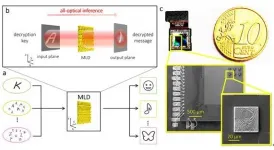
ELSE PRESS RELEASES FROM THIS DATE:
2021-03-11
Spatiotemporal metasurfaces, driven by ultrafast dynamic modulations, opened up new possibilities for manipulating the harmonic modes of electromagnetic waves and generations of exotic physical phenomena, such as dispersion cancellation, Lorentz reciprocity broken, and Doppler illusions. In recent years, rapid development of information technologies have stimulated many information processing applications for metasurfaces, including computational imaging, wireless communications, and performing mathematical operations. With increasing amount of researches focused on the topic of information processing ...
2021-03-11
Optical nonreciprocity, which prohibits the light field returning along the original path after passing through the optical system in one direction, is not only of vast interest to fundamental science, which brings us a deeper understanding of Lorentz reciprocity, time-reversal symmetry, and topological effects, but is also of great importance for realizing nonreciprocal optical and electromagnetics devices such as isolators, circulator and directional amplifiers, which are indispensable for applications ranging from optical communication to optical information processing.
However, realizing nonreciprocity is rather difficult as it requires breaking of the Lorentz reciprocity ...
2021-03-11
Looking at the night sky, one's thoughts might be drawn to astrochemistry. What molecules inhabit the vast spaces between the stars? Would we see the same molecules that surround us here on Earth? Or would some of them be more exotic--something rarely observed or even unknown?
Recent research by a multinational team led by Prof. Robert Ko?os from the Institute of Physical Chemistry of the Polish Academy of Sciences has revealed an unusual molecule obtained and detected for the first time in laboratory conditions and also paved a smooth path to produce and further study another. Now that they can be seen and studied, they may prove worthy ...
2021-03-11
Until now, it was only possible to optimize an acoustic cloaking structure for the air-environment. However, with this latest research, Acoustic cloak designed by topology optimization for acoustic-elastic coupled systems, published in the latest Applied Physics Letters, it is possible to design an acoustic cloak for underwater environments.
In the conventional topology optimization of acoustic cloaking, the design method was based on an analysis that approximated an elastic body in the air as a rigid body. However, since the approximation holds only for materials that are sufficiently ...
2021-03-11
Two types of materials are better than one when it comes to solar cells, as revealed by an international team that has tested a new combination of materials and architecture to improve solar-cell efficiency.
Silicon has long dominated as the premier material for solar cells, helped by its abundance as a raw material. However, perovskites, a class of hybrid organic-inorganic material, are a viable alternative due to their low-cost and large-scale manufacture and potentially higher performance. While still too unstable for full commercialization, they might become available to the market by 2022.
KAUST's Michele ...
2021-03-11
It was not the fly itself that caught the scientists' attention, but its bulging abdomen suggesting it was still full with the fly's last food intake. Surprisingly, analysis of the stomach content revealed it was full with pollen from different plants. The fossil pollen from the fly's stomach was used to reconstruct the ancient environment inhabited by the fly, the biotic interactions between plant and fly, and the fly's behaviour during feeding.
Flies as pollinators
Today, bees, butterflies and bumblebees are the typical pollinators, which are also known to feed on pollen. That flies also play an important role in pollination ...
2021-03-11
BOs describe the periodic movement of electrons in solids to which an external static electric field is applied. However, it is challenging to measure the BOs directly in natural solids since the relaxation time of electrons is usually much shorter than the oscillation period. To date, analogies of electron BOs have been extended to the synthetic dimensions of time, frequency and angular momenta. In previous studies, the frequency BOs have been experimentally demonstrated in a nonlinear fibre with cross-phase modulation. However, the frequency spectrum has ...
2021-03-11
An innovative analysis of two-dimensional (2D) materials from engineers at the University of Surrey could boost the development of next-generation solar cells and LEDs.
Three-dimensional perovskites have proved themselves remarkably successful materials for LED devices and solar panels in the past decade. One key issue with these materials, however, is their stability, with device performance decreasing quicker than other state-of-the-art materials. The engineering community believes the 2D variant of perovskites could provide answers to these performance issues.
In a study published in The Journal of Physical Chemistry Letters, researchers from Surrey's Advanced Technology Institute (ATI) detail how to improve the physical properties of 2D perovskite called Ruddlesden-Popper.
The study ...
2021-03-11
Recently, a research group led by Prof. WAN Yinhua from the Institute of Process Engineering (IPE) of the Chinese Academy of Sciences developed a novel targeted modification strategy to improve the separation selectivity of polyamide NF membranes.
The study was published in Journal of Membrane Science on March 10.
The low selectivity of commercial nanofiltration (NF) membranes to monosaccharides and monovalent salts is mainly due to the nonuniform pore size distribution and strong electronegativity.
Targeted modification can regulate the pore size distribution and electronegativity of polyamide NF membranes, and thus improve the separation selectivity.
In the strategy, carboxyl groups (-COOH) on the surface are activated by N-(3-Dimethylaminopropyl)-N'-ethyl ...
2021-03-11
An international collaboration headed by researchers from iPSYCH has found genetic variants that increase the risk of aggression in children with ADHD. In the same study, the researchers also discovered that the genetics which increase aggression in some children with ADHD, are the same genetics that affect aggression in children without a diagnosis.
For the first time, researchers have found positions in the genome that increase the risk of getting ADHD with disruptive behaviour disorders (DBDs). DBDs are child psychiatric disorders characterised by antisocial and ...
LAST 30 PRESS RELEASES:
[Press-News.org] AI holographic nanostructures on CMOS chips for energy-efficient security schemes


